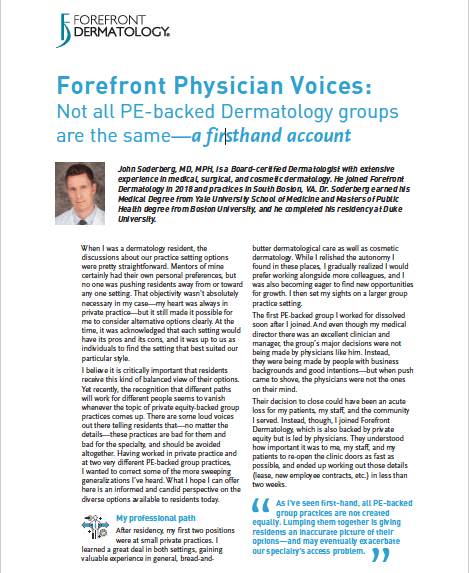My professional path
After residency, my first two positions were at small private practices. I learned a great deal in both settings, gaining valuable experience in general, bread-and-butter dermatological care as well as cosmetic dermatology. While I relished the autonomy I found in these places, I gradually realized I would prefer working alongside more colleagues, and I was also becoming eager to find new opportunities for growth. I then set my sights on a larger group practice setting.
The first PE-backed group I worked for dissolved soon after I joined. And even though my medical director there was an excellent clinician and manager, the group’s major decisions were not being made by physicians like him. Instead, they were being made by people with business backgrounds and good intentions—but when push came to shove, the physicians were not the ones on their mind.
Their decision to close could have been an acute loss for my patients, my staff, and the community I served. Instead, though, I joined Forefront Dermatology, which is also backed by private equity but is led by physicians. They understood how important it was to me, my staff, and my patients to re-open the clinic doors as fast as possible, and ended up working out those details (lease, new employee contracts, etc.) in less than two weeks.
“As I’ve seen first-hand, all PE-backed group practices are not created equally. Lumping them together is giving residents an inaccurate picture of their options—and may eventually exacerbate our specialty’s access problem.”
PE and the broader landscape
Most of us in dermatology understand our specialty’s current landscape. We have a continued problem with patient access. For Dermatologists, that means we are in extremely high demand, especially in rural areas and smaller cities. This combination of patient need and physician scarcity has led health systems to add dermatology services or buy up existing clinics, and it has also opened the doors for new players like private equity groups to enter the specialty. Meanwhile, sole-owner private practices are on the wane due to increased regulatory pressures, more complex administrative responsibilities, the immense financial risk involved, and the chilling effect that combination has had on younger dermatologists.
I consider myself somewhat representative of this generational shift: I’ve always cherished the autonomy and pace of private practice, but I’m realistic about the financial uncertainty, personal trade-offs, and massive amount of time I’d spend on administrative tasks if I were to open my own clinic. Instead, then, I’ve sought out opportunities where I can enjoy certain aspects of private practice and patient care—but in a more stable, less stressful, and more patient-focused context.
With this landscape and these trends in mind, our goal as a specialty should be to expand access sustainably and responsibly, without diluting our value as Board-certified Dermatologists.
Well-resourced PE-backed group practices, when they are structured appropriately, answer many of these problems. They take care of the challenges that are keeping younger physicians from starting their own practices (e.g., administrative burden, financial risk) while placing experienced Dermatologists in underserved areas that can sustain the clinic.
Correcting the record
But what about the over-biopsying? The corporatization of dermatology? What about the requirement that Dermatologists in PE-backed group practices use a specific lab, or send patients to a specific Mohs surgeon? The critiques are well publicized, if often inaccurate, and residents have been hearing them a lot. My experience does not bear them out.
First, no one is dictating to me how many patients to see or how I should practice. I am never encouraged to perform unnecessary biopsies, and comparisons show that Forefront as a whole does fewer biopsies than its peers. Second, I do have the option to send my specimens to our dermatopathology lab, and would have the option to use one of Forefront’s Mohs surgeons if there were one in my region. But unlike at an academic setting, where labs are automatically processed in house and surgical referrals invariably go to a surgeon on staff, I have never once been pressured to use our lab. (While our dermpath lab is excellent, if I feel that for some reason it’s not in the best interests of my patients to use it, I don’t.) Finally, and this applies to both PE-backed practices I’ve worked in, I have never felt like a cog in a wheel.
Ultimately, Forefront differs most from my earlier experience in that it is, and has always been, physician-led. Unlike that other group, every decision about Forefront’s direction, growth, and backing is made by physicians. What that means on the ground is that this group is looking out for its Dermatologists, and it trusts us to look out for our patients. Our physician leaders will only partner with a private equity partner who respects that arrangement and understands the value it provides.
Conflict of interest?
Critics of PE often claim that views like mine come only from shareholders— and that their investments create an inescapable conflict of interest. While I firmly disagree with that view, I am not currently a shareholder in Forefront.
Private equity structures are creating opportunities for more physicians to be owners without having to take on the full burden of running a business and serving patients. In my view, that’s a good thing. Being a shareholder fosters a sense of ownership in the practice, and that sense of ownership means that the group’s Dermatologists have a greater stake in the reputation of the group and its future, which in turn means they are directly concerned with the overall care provided by the group.
I mentioned that I’m not currently a Forefront shareholder. For all of these reasons, though, I certainly aspire to be one in the future.
The elephant in the room
I don’t ever want to sound like a cheerleader, but if it weren’t for Forefront, the town I work in would not have a Dermatologist. I’m not sure what PE’s loudest critics would say to that—have they shared a plan for meeting the massive access problem facing our patients?
If their answer is to encourage more young doctors to open solo practices, that may indeed be the right option for some of us (especially those who are entrepreneurially inclined). That path is simply less workable for others, though. The properly vetted PE-backed group practice can bridge some of the gaps residents and early career Dermatologists face today, by providing a mix of autonomy and administrative peace of mind, for instance, which allows us to focus more fully on caring for patients.
Having come from a public health background, I take great satisfaction in knowing I’m a part of a group providing complete dermatological care to underserved populations, and I’m personally happy that I can make that difference while honing my clinical skills and working alongside other dedicated physicians. I wouldn’t be here if I had accepted the critiques without investigating for myself—or assumed that if you know one PE-backed group practice, you know them all. And that’s why I’m writing—to encourage residents to keep an open mind and explore their options for themselves.
 John Soderberg, MD, MPH, is a Board-certified Dermatologist with extensive experience in medical, surgical, and cosmetic dermatology. He joined Forefront Dermatology in 2018 and practices in South Boston, VA. Dr. Soderberg earned his Medical Degree from Yale University School of Medicine and Masters of Public Health degree from Boston University, and he completed his residency at Duke University.
John Soderberg, MD, MPH, is a Board-certified Dermatologist with extensive experience in medical, surgical, and cosmetic dermatology. He joined Forefront Dermatology in 2018 and practices in South Boston, VA. Dr. Soderberg earned his Medical Degree from Yale University School of Medicine and Masters of Public Health degree from Boston University, and he completed his residency at Duke University.